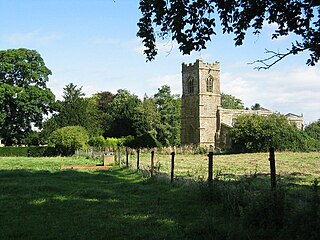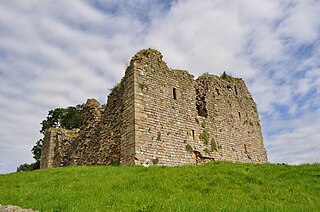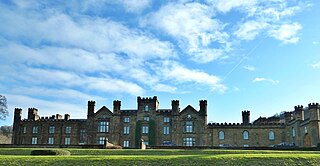
Richard Grosvenor, 2nd Marquess of Westminster, styled The Honourable Richard Grosvenor from 1795 to 1802, Viscount Belgrave from 1802 to 1831 and Earl Grosvenor from 1831 to 1845, was an English politician, landowner, property developer and benefactor.

Aske Hall is a Georgian country house, with parkland attributed to Capability Brown, 1.5 miles (2.4 km) north of Richmond, North Yorkshire, England. It contains an impressive collection of 18th-century furniture, paintings and porcelain, and in its grounds a John Carr stable block converted into a chapel in Victorian times with Italianate decor, a Gothic-style folly built by Daniel Garrett circa 1745, coach house with carriage, Victorian stable block, walled garden, terraced garden and lake with a Roman-style temple. The hall and estate are currently owned by the Marquess of Zetland.

The Swinburne Baronetcy, of Capheaton in the County of Northumberland, was a title in the Baronetage of England. It was created on 26 September 1660 for John Swinburne in honour of the loyalty to Charles I of Swinburne's father and grandfather prior to and during the English Civil War. He demolished Capheaton Castle in 1668 and built a new house on the site. The sixth baronet was member of parliament for Launceston in 1788-9 and High Sheriff of Northumberland in 1799. His grandson, the seventh baronet, was High Sheriff in 1866 and member of parliament for Lichfield 1885–1892. His son, the eighth baronet was High Sheriff in 1920. The title became extinct on the death of the tenth baronet in 1967.

Sir John Swinburne, 7th Baronet was a British Baronet and Liberal politician.

Ayston is a village and civil parish in the county of Rutland in the East Midlands of England. It is about one mile (1.6 km) north-west of Uppingham, close to the junction of the A47 and A6003. The population of the village was less than 100 at the 2011 census and is included in the civil parish of Ridlington. The placename means Aethelstan's farm or settlement; the estate was granted to Aethelstan, a minister of Edward the Confessor, in 1046.

Stanwick St John is a village, civil parish, former manor and ecclesiastical parish in the Richmondshire district of North Yorkshire,, England. It is situated between the towns of Darlington and Richmond, close to Scotch Corner and the remains of the Roman fort and bridge at Piercebridge.

Hugh Percy, 1st Duke of Northumberland,, was an English peer, landowner, and art patron.

Capheaton is a village and civil parish in Northumberland, England, about 25 miles (40 km) to the northwest of Newcastle upon Tyne. The population at the 2001 census was 160, increasing to 175 at the 2011 Census. It was built as a planned model village in the late eighteenth century. The name Capheaton derives from Caput Heaton, i.e., Heaton Magna, nearby Kirkheaton being the original Heaton Parva.
This is a list of the High Sheriffs of the English county of Northumberland. The High Sheriff is the oldest secular office under the Crown. Formerly the High Sheriff was the principal law enforcement officer in the county but over the centuries most of the responsibilities associated with the post have been transferred elsewhere or are now defunct, so that its functions are now largely ceremonial. The High Sheriff changes every March.

Cobham Hall is an English country house in the county of Kent, England. The grade I listed building is one of the largest and most important houses in Kent, re-built as an Elizabethan prodigy house by William Brooke, 10th Baron Cobham (1527–1597). The central block was rebuilt 1672–82 by Charles Stewart, 3rd Duke of Richmond, 6th Duke of Lennox (1639–1672).

Thirlwall Castle is a 12th-century castle in Northumberland, England, on the bank of the River Tipalt close to the village of Greenhead and approximately 20 miles (32 km) west of Hexham. It was built in the 12th century, and later strengthened using stones from nearby Hadrian's Wall, but began to fall into disrepair in the 17th century. The site is protected by Grade I listed building and Scheduled Ancient Monument status.

The Swinton Estate is a large privately owned estate in North Yorkshire, England. It comprises some 20,000 acres (81 km2) of countryside in the Nidderdale Area of Outstanding Natural Beauty, extending 10 miles (16 km) west from the River Ure near Masham. The estate includes Swinton Park, the seat of the Danby family and of the Cunliffe-Lister family, an English country house in Swinton near Masham. It is set in 200 acres (0.81 km2) of parkland, lakes and gardens. The house is a Grade II* listed building, and now operates as the 42-bedroom Swinton Park Hotel.

Kirkley Hall is a 17th-century historic country mansion and Grade II listed building in Northumberland, England. The estate is over 190 acres (0.77 km2) and adjoins the River Blyth at Kirkley, three miles north of Ponteland in the heart of the Northumberland countryside, which is now a Horticultural and Agricultural training centre.

Netherwitton Hall is a mansion house, and a Grade I listed building at Netherwitton, near Morpeth, Northumberland,

Matfen Hall is a 19th-century country mansion in Matfen, Northumberland, England, the seat of the Blackett baronets and now also a hotel and country golf club. It is a Grade II* listed building.

Wilton Castle is an early 19th-century mansion, built on the site of a medieval castle, now converted into residential apartments, situated at Wilton, in Redcar and Cleveland, North Yorkshire, England. It is a Grade II listed building.

Sir John Swinburne, 6th Baronet was an English politician and patron of the arts.

Architecture of Wales is an overview of architecture in Wales from the medieval period to the present day, excluding castles and fortifications, ecclesiastical architecture and industrial architecture. It covers the history of domestic, commercial, and administrative architecture.

Dowsby Hall is an early 17th-century house situated in Dowsby, Lincolnshire, England, and 6 miles (10 km) to the north of Bourne. Originally a much grander house, attributed to the architect John Thorpe, it was converted to farm house in the late 18th century. It is listed Grade II*. From about 1920 to 1987, it was the home of Henry Burtt, who suggested the idea of the radio programme The Archers to the BBC producer Godfrey Baseley.

Algernon Charles Swinburne was an English poet, playwright, novelist, and critic. He wrote several novels and collections of poetry such as Poems and Ballads, and contributed to the famous Eleventh Edition of the Encyclopædia Britannica.



















